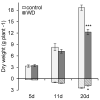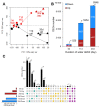Transcriptomic, Metabolomic and Ionomic Analyses Reveal Early Modulation of Leaf Mineral Content in Brassica napus under Mild or Severe Drought
- PMID: 35054964
- PMCID: PMC8776245
- DOI: 10.3390/ijms23020781
Transcriptomic, Metabolomic and Ionomic Analyses Reveal Early Modulation of Leaf Mineral Content in Brassica napus under Mild or Severe Drought
Abstract
While it is generally acknowledged that drought is one of the main abiotic factors affecting plant growth, how mineral nutrition is specifically and negatively affected by water deficit has received very little attention, other than being analyzed as a consequence of reduced growth. Therefore, Brassica napus plants were subjected to a gradual onset of water deficits (mild, severe, or severe extended), and leaves were analyzed at the ionomic, transcriptomic and metabolic levels. The number of Differentially Expressed Genes (DEGs) and of the most differentially accumulated metabolites increased from mild (525 DEGs, 57 metabolites) to severe (5454 DEGs, 78 metabolites) and severe extended (9346 DEGs, 95 metabolites) water deficit. Gene ontology enrichment analysis of the 11,747 DEGs identified revealed that ion transport was one of the most significant processes affected, even under mild water deficit, and this was also confirmed by the shift in ionomic composition (mostly micronutrients with a strong decrease in Mo, Fe, Zn, and Mn in leaves) that occurred well before growth reduction. The metabolomic data and most of the transcriptomic data suggested that well-known early leaf responses to drought such as phytohormone metabolism (ABA and JA), proline accumulation, and oxidative stress defense were induced later than repression of genes related to nutrient transport.
Keywords: abscisic acid; genes related to transport; glutathione; ionome; jasmonic acid; mineral nutrition; proline; water deficit.
Conflict of interest statement
The authors declare no conflict of interest.
Figures










References
-
- Dai A. Increasing Drought under Global Warming in Observations and Models. Nat. Clim. Chang. 2013;3:52–58. doi: 10.1038/nclimate1633. - DOI
-
- Qaderi M.M., Kurepin L.V., Reid D.M. Growth and Physiological Responses of Canola (Brassica napus) to Three Components of Global Climate Change: Temperature, Carbon Dioxide and Drought. Physiol. Plant. 2006;128:710–721. doi: 10.1111/j.1399-3054.2006.00804.x. - DOI
-
- Champolivier L., Merrien A. Effects of Water Stress Applied at Different Growth Stages to Brassica napus L. Var. Oleifera on Yield, Yield Components and Seed Quality. Eur. J. Agron. 1996;5:153–160. doi: 10.1016/S1161-0301(96)02004-7. - DOI
-
- Ghobadi M., Bakhshandeh M., Fathi G., Gharineh M.H., Alami-Said K., Naderi A., Ghobadi M.E. Short and Long Periods of Water Stress during Different Growth Stages of Canola (Brassica napus L.): Effect on Yield, Yield Components, Seed Oil and Protein Contents. J. Agron. 2006;5:336–341.
-
- Branka K., Bosko Andrija G., Angelina T., Goran D. Yield and Chemical Composition of Soybean Seed under Different Irrigation Regimes in the Vojvodina Region. Plant Soil Environ. 2017;63:34–39. doi: 10.17221/673/2016-PSE. - DOI
MeSH terms
Substances
Grants and funding
LinkOut - more resources
Full Text Sources
Medical
Molecular Biology Databases

